Class 9 Science: Sample Question Paper- 6 (With Solutions) PDF Download
Q.1. Define Latent Heat of Vapourisation
Ans. Latent heat of vaporisation is the heat energy required to change 1 kg of a liquid to gas at atmospheric pressure at its boiling point.
Q.2. A cell wall swell up if
(a) the concentration of water molecules in the cell is higher than the concentration of water molecules in surrounding medium.
(b) the concentration of water molecules in surrounding medium is higher than water molecules concentration in the cell.
(c) the concentration of water molecules is same in the cell and in the surrounding medium
(d) concentration of water molecules does not matter.
Or
The only cell organelle seen in prokaryotic; cell is
(a) Mitochondria
(b) Ribosome
(c) Plastids
(d) Lysosomes
Ans. (b) The concentration of water molecules in surrounding medium is higher than water molecules concentration in the cell.
Explanation: The medium surrounding the cell is hypotonic in nature as compare to the cell's cytoplasm. So, in this situation water from the surrounding's hypotonic solution (lower concentration of solute in water) is forced to enter the cell through the cell membrane due to the process of endosmosis and cause the cell to swell.
OR
(b) Ribosomes
Explanation: A prokaryotic cell lacks membrane bound organelles like plastids, mitochondria and endoplasmic reticulum but smaller and randomly scattered ribosomes are seen.
Q.3. If the speed of an object is doubled then its
(а) kinetic energy is doubled.
(b) kinetic energy is raised to 4 times of its initial value.
(c) potential energy is doubled.
(d) potential energy becomes 4 times of its initial value.
Ans. (b) Kinetic energy of an object  If speed of the object is doubled then obviously its kinetic energy is raised to four times of its initial value.
If speed of the object is doubled then obviously its kinetic energy is raised to four times of its initial value.
Q.4. Question number 4 is based on the paragraph given below. Study this paragraph and answer the questions that follow.
Surface tension of liquids is a molecular phenomenon involving the force of cohesion or attraction among the liquid molecules. It is a scalar quantity. Numerically it is proved that the potential energy of a liquid is maximum on the surface. Surface tension of a liquid is independent of surface area but it depends on the intermolecular force and temperature. It is defined as the force acting on the surface at right angle of unit length. Sparingly soluble salts decrease the surface tension of liquid while fairly soluble solutes increase the surface tension of the liquid.
(I). Surface tension of a liquid does not depend on :
(a) temperature
(b) intermolecular force
(c) surface area
(d) solute dissolved in liquid
Ans. (c)
(II). Which o f the follow in g has highest surface tension ?
(a) Water
(b) Soap in water
(c) Detergent in water
(d) Glycerol in water
Ans. (d)
(III). Which o f the follow in g phenomenon is not due to surface tension ?
(a) Small droplets are spherical in shape
(b) Water rises in ac apillary
(c) Oil rises in a lamp wick
(d) Insects can not walk on water.
Ans. (d)
(IV). The unit of surface tension is :
(a) dyne cm-1
(b) Joules cm-2
(c) calorie
(d) cm3
Ans. (a)
Q.5. In SONAR, we use
(a) Ultrasonic waves
(b) Infrasonic waves
(c) Radio waves
(d) Audible sound waves
Ans. (a) Ultrasonic waves
Explanation: SONAR is a device that uses ultrasonic waves to measure the distance, direction and speed of underwater objects.
Q.6. What are the properties of a suspension ?
(a) It is a heterogeneous mixture.
(b) Particles can be seen with a naked eye.
(c) Particles scatter light.
(d) All the above
Ans. (d)
Q.7. A body is whirling a stone tied with a string in an horizontal circular path. If the string breaks, the stone :
(a) will continue to move in the circular path
(b) will move along a straight line towards the centre of the circular path
(c) will move along a straight line tangential to the circular path
(d) will move along a straight line perpendicular to the circular path away from the body
Ans. (c)
Q.8. Tincture of iodine has antiseptic properties. This solution is made by dissolving
(a) iodine in potassium iodide
(b) iodine in vaseline
(c) iodine in water
(d) iodine in alcohol
Ans. (d) iodine in alcohol
Explanation: Tincture of iodine is made by dissolving iodine in alcohol.
Q.9. The book ‘Systema Naturae’ was written by :
(c) Robert Brown
(b) Linnaeus
(c) Whittaker
(d) Haeckel
Ans. (b)
Q.10. Which among the following has specialised tissue for conduction of water ?
(i) Thallophyta
(ii) Bryophyta
(iii) Pteridophyta
(iv) Gymnosperms
(a) (i) and (ii)
(b) (ii) and (iii)
(c) (iii) and (iv)
(d) (i) and (iv)
Ans. (c)
Q.11. Mass of a body is doubled. How does its acceleration change under a given force ?
OR
When a carpet is beaten with a stick it releases dust. Explain why ?
Ans. Acceleration becomes half.
Detailed Answer:
P = ma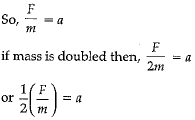
Hence,, acceleration becomes half.
OR
Inertia of an object tends to resist any change in its state of rest or state of motion. When a carpet is beaten with a stick, then the carpet comes to motion. Whereas, the dust particles resist their state of rest. The dust particles stay in a state of rest while the carpet moves. So, the dust falls down.
Q.12. Most distinctive feature of organisms belonging to Annelida is presence of ______________in their body.
Ans. segments
Q.13. For these question two statements are given- one labelled Assertion (A) and the other labelled Reason (R). Select the correct answer to these questions from the codes (i), (ii), (iii) and (iv) as given below
(i) Both A and R are true and R is correct explanation of the assertion.
(ii) Both A and R are true but R is not the correct explanation of the assertion.
(iii) A is true but R is false.
(iv) A is false but R is true.
Assertion : Mammals are warm-blooded animals with four-chambered hearts. They have mammary glands for the production of milk to nourish their young. Their skin has hairs as well as sweat and oil glands.
Reason : Most mammals familiar to us produce live young ones. However, a few of them like the platypus and the echidna lay eggs, and some, like kangaroos give birth to very poorly developed young ones.
(i) A
(ii) B
(iii) C
(iv) D
Ans. (i)
Q.14. In what direction does the buoyant force on an object immersed in a liquid act ?
Ans. It acts on an object in the vertically upward direction.
Section - D
Q.15. Water as ice has a cooling effect, whereas water as steam may cause severe bums. Explain these observations.
Ans. In case of ice, the water molecules have low energy while in the case of steam the water molecules have high energy. The high energy of water molecules in steam is transformed as heat and may cause bums. On the other hand, in case of ice, the water molecules take energy from the body and thus give a cooling effect.
Q.16. A radio station is transmitting its signals at a frequency of 400 MHz. If the velocity of radio waves is 3 x 108 m/s, calculate the wavelength of radio waves.
OR
(i) Name the characteristic of sound that helps us to distinguish a note played on a sitar and a violin.
(ii) In a submarine fitted with a SONAR, the time interval between the generation of an ultrasonic wave and the receipt of its echo from an enemy submarine is 200 sec. What is the distance of the enemy submarine ? Given : Speed of sound in water is 1450 m/s.
Ans.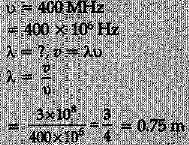
Or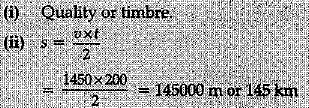
Q.17. (a) Flash and thunder are produced simultaneously. However, thunder of a cloud is heard a bit late than the flash of lightning is seen. Explain why.
(b) Sound produced by thunderstorm is heard 10 s' after the lightning is seen. Calculate the approximate distance of the thunder cloud. (Given : Speed of sound in air = 340 m/s)
Ans. (a) In lightning process, flash and thunder are produced simultaneously. Flash is seen almost immediately because speed of light is extraordinarily large (c = 3 x 108 ms-1). But thunder is heard a few seconds later because speed of sound is much less (about 346 m s-1 at 25 °C) and requires time to cover up the distance from the site of thunder in sky to us.
(b) Given that speed of sound in air v = 340 m/s and time of thunder t = 10 s.
∴ Distance of the thunder cloud s = vt = 340 x 10 = 3400 m or 3.4 km
Q.18. Justify the following statements :
(a) "Availability of proper and sufficient food would prevent infectious diseases."
(b) "The general ways o f preventing infection mostly relate to preventing exposure". List three points of prevention of exposure.
Or
With the help of a labelled diagram show the carbon cycle in nature. Describe the two ways in which carbon dioxide is fixed in the environment.
Ans. (a) Yes.
Because functioning of immune system will not be good if proper and sufficient food and nourishment is not available.
(b) Yes.
(i) For air borne microbes, we can prevent exposure by providing living condition that are not overcrowded.
(ii) For water borne microbes, we can prevent exposure by providing safe drinking water.
(iii) For vector borne diseases, we can prevent exposure by providing clean environment.
Or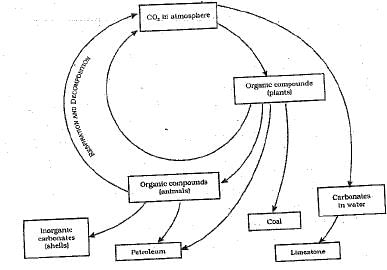
(i) Conversion of C02 into glucose by green plants in the presence of sunlight during photosynthesis.
(ii) Usage of carbonates dissolved in sea water by marine animals to make their shells.
Q.19. (i) You are given a mixture of mustard oil and water. Name the process that can be used to obtain mustard oil from the above mixture.
(ii) Draw a well labelled diagram of the above process.
Ans.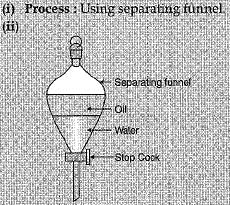
Q.20. Write the names of the compounds represented by the following formula :
(i) Mg(NG3)2
(ii) K2SO4
(iii) Ca3N2
Or
(a) State the basic difference between atoms and molecules.
(b) Why does not atomic mass of an element represent the actual mass of its atoms ?
(c) “The atomic mass of an element is in fraction.” What does this mean ?
Ans.
Or
(a) Atom is the building block of all matter.
A molecule is a general a group of two or more atoms of the same or different elements that are chemically bonded.
(b) The actual mass of an atom is extremely small. We represent the mass of an atom as a relative mass compared to 1/12 of the mass of one carbon-12 atom.
(c) Many of the elements have isotopes with different masses. The atomic mass of an element is the average of the masses of these isotopes which comes out to be a fraction.
Q.21. What are the two forms of oxygen found in the atmosphere ?
Ans. (i) Elemental oxygen is normally found in the form of a diatomic molecule (O2) in the lower regions of the atmosphere to the extent of 21%. It is non-poisonous form of oxygen.
(ii) But in the upper reaches of the atmosphere (stratosphere), it occurs in the form of ozone, containing three atoms of oxygen and having the molecular formula O3. It is the poisonous form of oxygen.
Some other forms of Oxygen:
It also occurs extensively in the combined form in the Earth's crusl as well as also in the air in the form of carbon dioxide. In the crust,, it is found as the oxides of most metals and silicon, and also as carbonate, sulphate, nitrate and other minerals. It is also an essential component of most biological molecules like carbohydrates, proteins, nucleic acids and fats (or lipids).
Q.22. Mention the problem which is associated with using local names of organisms. How was this resolved? Name the scientist who had introduced the above solution.
Ans. Local names vary from place to place. So, it becomes difficult for people speaking or writing in different language to know and understand if they are talking or discussing about the same organism. This problem was resolved by using internationally accepted scientific name for organism (Binomial nomenclature).
Carl Linnaeus gave a binomial nomenclature system, which is widely accepted.
Q.23. (a) Name any one disease caused by bacteria and virus.
(b) Why are antibiotics effective against bacteria hut not viruses ?
Ans. (a) Disease caused by :
(i) Bacteria — Tuberculosis
(ii) Virus — AIDS (Acquired Immuno-Deficiency Syndrome)
(b) Antibiotics act by preventing one of the bio-chemical events towards formation of a new pathogen cell. Thus, most prevent cell wall formation, which happens in bacterial cell only, thereby preventing bacterial diseases.
Q.24. An automobile engine propels a 1000 kg car (A) along a levelled road at a speed of 36 km R-1. Find the power if the opposing frictional force is 100 N. Now, suppose after travelling a distance of 200 m, this car collides with another stationary car (B) of same mass and comes to rest. Let its engine also stop at the same time. Now, car (B) starts moving on the same levelled road without getting its engine started.
Find the speed of the car (B) just after the collision.
Or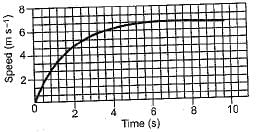
(a) Find how far does the car travel in the first 4 seconds. Shade the area on the graph that represents the distance travelled by the car during the period.
(b) Which part of the graph represents uniform motion of the car
Ans. Given : m = 1000 kg, F = 100 N, v = 36 km h-1 = 10 ms-1
Using P = Fu, we have
P = 100 x 10
= 1000 w
By law of conservation of momentum, we have
Momentum of car A + Momentum of car B before collision = Momentum of car A + Momentum of car B after collision i.e.,
1000 x 10 + 1000 x o = 1000 x o + 1000 x V
V = 10 m s-1
Thus, speed of car B just after collision = 10 m s-1.
Or
(a) The car travels with a non-uniform speed which is non- accelerated in nature.
The distance travelled by the car in the first four second is given by the area enclosed by the speed-time graph and X-axis from t = 0 to t = 4 s.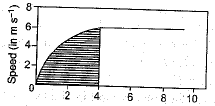
To calculate the distance, in such cases; we actually count the number of-squares in the shaded portion of the graph. This gives the distance travelled by the car in first four seconds as 17.80 m.
(b) The straight line portion of the graph represents uniform motion of the car.
Section - C
Q.25. Fill in the missing data in the Table
(a)
(b) The visible universe is estimated to contain 1022 stars. How many moles of stars are present in the visible universe ?
(c) Compute the difference in masses 103 moles each of magnesium atoms and magnesium ions. (Mass of an electron = 9.1 x 10-31kg)
Or
Give a brief account of the development of the presently accepted model of atom with the contributions made by different scientists. Write two features of this atomic modal.
Ans. (a)
(b) Number of moles of stars = 
(c) A Mg2+ ion and Mg atom differ by two electrons.
103 moles of Mg2+ and Mg atoms would differ by 103 x 2 moles of electrons.
Mass of 2 x 103 moles of electrons
= 2 x 103 x 6.022 x 1023 x 9.1 x 10-31kg
= 2 x 6.022 x 9.1 x 10-5kg
= 109.6004 x 10-5kg = 1.096 x 10-3kg
Or
Thomson's model: He proposed that atom is sphere of positive charge having negatively charge embedded in it. The amounts of positive and negative charges on the atom are equal.
Rutherford's model: He proposed that atom has a central positively charged nucleus which possesses entire mass of the atom and is very small in comparison to the size of the atom. The electrons revolve around the nucleus in definite circular path.
Bohr's model:
(i) Atom has central positively charged nucleus with the entire mass concentrated in it.
(ii) Electrons revolve around the nucleus in well defined circular orbits known as discrete orbits of electrons.
(iii) While revolving in these orbits electrons do not radiate energy.
Q.26. (i) Define kinetic energy. Derive an expression for the kinetic energy of an object.
(ii) The power of a motor pump is 5 kW How much water per minute the pump can raise to height of 20m ? Take g = 10 ms-2.
Or
(i) Define the work done by a constant force. Write its SI unit and define this unit.
(ii) A 3000 kg truck moving at a speed of 90 m/s stops after covering some distance. The force applied by brakes is 27000 N. Compute the distance covered and work done by this force.
Ans. (i) Energy possessed by a body by virtue of motion,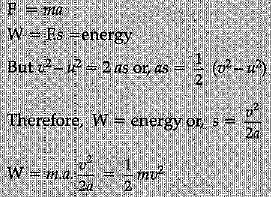
(ii)
Detailed Answer:
(i) Let us take an equation of motion.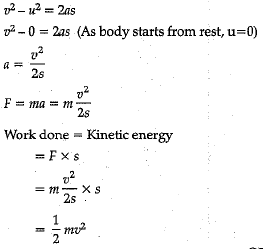
Or
(i) Work is said to be done when a force acts on an object and the object covers some distance. : Its SI unit is Joule.
One joule: When a force of 1 N moves a body through a distance of 1 meter in its own direction
(ii)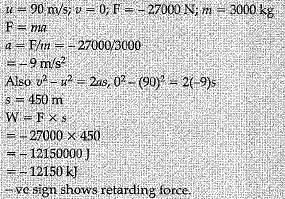
Q.27. Give reasons for the following :
(a) Isotopes of an element are chemically similar.
(b) An atom is electrically neutral.
(c) Noble gases show least reactivity.
(d) Ions are more stable than atoms.
(e) Na+ has completely filled K and L shells.
Ans. (a) Chemical properties of an element depend upon the atomic number. All the isotopes of an element have the same atomic number and therefore are chemically similar.
(b) An atom has the equal number of positively charged protons and negatively charged electrons. Therefore atom is electrically neutral.
(c) Noble gases contain 8 electrons in the outermost shell (2 in case of helium). This is the maximum capacity of the outermost shell. Hence they show least reactivity.
(d) Ions are more stable than atoms because the former have an octet structure.
(e) Electronic configuration of Na is
Na+ is formed from Na by removing the electron from the M shell. Therefore it has the completely filled K and L shells.
Q.28. Give the characteristics and role of the following:
(i) Cutin (ii) Suberin (iii) Sclereids
Or
(a) Name the different components of xylem and draw a living component
(b) What are plastids ? Give the various types of plastids present in plants along with their functions.
Ans. (i) Cutin: Cutin is a waterproof layer of waxy substance. Epidermis is one cell thick and is covered with cuticle. This cuticle has a variable thickness and is more thicker in xerophytic plants.
(ii) Suberin : It is a complex polymer present in the walls or cork cells; It makes cell wall impervious to gases and water.
(iii) Sclereids: These are sclerenchymatous cells which are short and possess extremely thick lignified walls with long tubular simple pits. They are short and are irregular shaped.
Or
(a) Xylem consists of tracheids, vessels, xylem parenchyma and xylem fibres.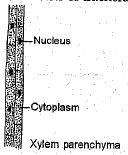
(b) Plastids are present only in plant cells. Just like the mitochondria, plastids also have their own DNA and ribosomes and thus they are able to make some of their own proteins
Q.29. (a) What do signs and symptoms indicate if a person is suffering from any disease ?
(b) Based on the duration of disease what are the different categories of diseases ?
Differentiate between them with one example each.
Ans. (a) Symptoms indicate that there may be a disease, but don't indicate what the disease is. Sign of a disease is a definite indication of the presence of a particular disease, Physicians get laboratory; test done to pinpoint the disease.
(b) Acute and Chronic diseases.
Differences:
Acute
(i) Last for short period of time.
(ii) Do not cause effect on general health, e.g., Common cold.
Chronic
(i) Lasts for long time even for lifetime.
(ii) Causes major effect on general health. e.g., Diabetes.
Q.30. Answer the following :
(i) Draw a labelled diagram of smooth muscle.
(ii) Differentiate between parenchyma and sclerenchyma.
(iii) Name the epithelium which has hair-like projection on outer surface of the cells.
(iv) Name a tissue that stores fat in the body.
Or
Explain in detail about the effect of change in temperature of water bodies on aquatic organisms.
Ans. (i)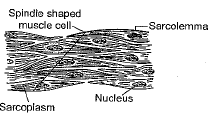
(ii) Distinction between parenchyma and sclerenchyma on the basis of their cells wall:
(iii) Ciliated epithelium.
(iv) Adipose tissue
Or
Effect of change in temperature of water bodies on aquatic animals is described as under :
(i) This affects the balance between various organisms which have been established in the system.
(ii) This leads to removal of useful substances like oxygen and other nutrients from the water bodies.
(iii) The eggs and larvae of animals are sensitive to temperature changes. Some animals face the threat of extinction.
(iv) Breeding of animals is affected by temperature changes.
(v) It encourages the growth of some life forms and destroy some other forms.
FAQs on Class 9 Science: Sample Question Paper- 6 (With Solutions)
| 1. What are some important topics to study for the Class 9 Science exam? |  |
| 2. How can I prepare for the Class 9 Science exam effectively? |  |
| 3. What is the importance of solving sample question papers for the Class 9 Science exam? |  |
| 4. Are there any online resources available for studying Class 9 Science? |  |
| 5. How can I score well in the Class 9 Science exam? |  |














